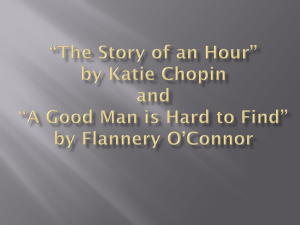File
advertisement
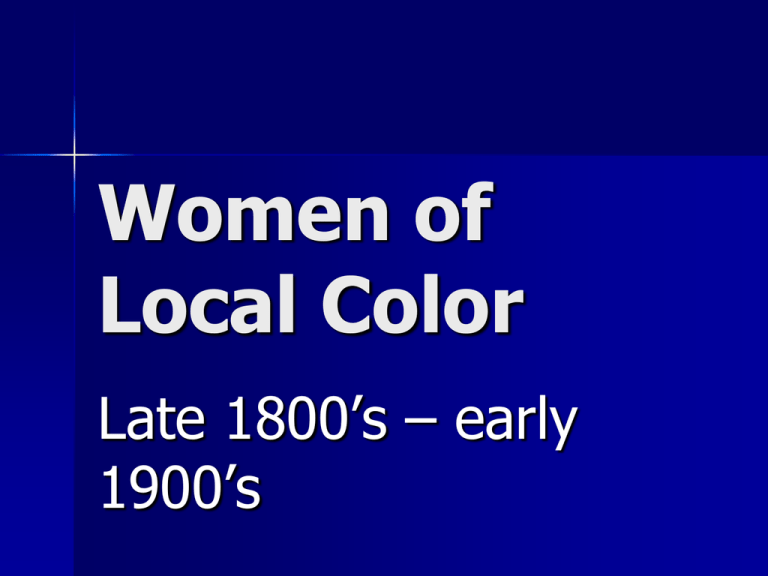
Women of Local Color Late 1800’s – early 1900’s What is ‘local color” Writing that captures the essence of an area Distinctive qualities of the people Habits Speech, vernacular Customs Beliefs Major Women Players Mary Wilkes Freeman in the Northeast Sarah Orne Jewett in the Northeast Kate Chopin in the Louisiana bayous Charlotte Perkins Gilman and women’s turn of the century situation Willa Cather in the Midwest Mary Wilkes Freeman 1852-1930 Major works published - 18871891 Explored the lives of mature New England women who confront their poverty Recognize their isolation Struggle to preserve their dignity Freeman’s life In the 1880’s her father lost his business, her sister died, mother had to work as a housekeeper Within the next 3 years her parents died suddenly Freeman was alone and destitute and turned to writing. Her writing conveys the honesty of poor women At age 49, she met Dr. Charles Freeman. Ten years later she married him. Two tears later he was committed to an insane asylum for alcoholism The end of their marriage and his life were long and messy Freeman’s Work 20 volumes of fiction and children’s stories A Humble Romance and Other Stories in 1887 A New England Nun and Other Stories in 1891 Reading Target “The Revolt of Mother” Look for specific examples of local color in this tale of a fierce independent New England woman struggling to give her family a better life. Look for irony and humor. Sarah Orne Jewett 1849-1909 Major works published 1873-1891 Influenced by Harriet Beecher Stowe, another ‘Mainah’ and local colorist Fascinated with the depth and character of relationships with women Encouraged realistic depiction of specific environments, moods, relationships, customs and characters without a traditional protagonist/antagonist plot. Jewett’s Life Grew up in South Berwick, Maine as daughter of a country doctor. Graduated from South Berwick Academy in 1865 and began writing short fiction. Grounded her personal life in close relationships with women, the most important of which was a 30 year relationship with Annie Fields – know as a Boston Marriage Fields/Jewett house on Back Bay in Boston was emotional center as well as literary center for publishing world. Connect 2 generations of women writers, Stowe to Jewett to Chopin Jewett’s Work Features everyday life of ordinary Mainers. She’s different because she focused on idiomatic language, conservative values, imagery and vivid description of rural New England. A Country Doctor early in her career shows a young woman choosing to become a physician rather than marry The Country of the Pointed Firs towards the end of her career dealt with rural community, female friendship, and the making of art “A White Heron,” her most famous work, dramatizes the clash between competing sets of values urban/rural, scientific/empathetic, masculine/feminine, and adult/juvenile Jewett Reading Using Jewett’s “A White Heron,” find examples of local color – habits, speech, customs, beliefs as well as any examples of competing values of urban/rural, scientific/empathetic, masculine/feminine, and adult/juvenile Using Jewett’s “Miss Tempty’s Watcher’s,” look for irony and humor Kate Chopin 1850-1904 Major works published in 1890’s Wrote two published novels and about a hundred short stories Most of her fiction is set in Louisiana Most of her best-known work focuses on the lives of sensitive, intelligent women Her short stories were well received in her own time and were published by some of America's most prestigious magazines—Vogue, the Atlantic Monthly, Harper's Young People, Youth's Companion, and the Century. Kate Chopin 1850-1904 Born in St. Louis, Missouri 2nd child of Thomas O’Flaherty of Ireland and Eliza Faris of St. Loius. Mother’s side of the family was of French decent so Kate grew up speaking both English and French. As a girl, she was mentored by woman--by her mother, her grandmother, and her great grandmother, as well as by the Sacred Heart nuns. Kate formed deep bonds with her family members, with the sisters who taught her at school, and with her life-long friend Kitty Garasché. Much of the fiction Kate wrote as an adult draws on the nurturing she received from women as she was growing up. Kate Chopin 1850-1904 Her early life had a great deal of trauma. In 1855, her father was killed in a railroad accident. In 1863 her beloved Frenchspeaking great grandmother died. Kate spent the Civil War in St. Louis, torn between the north and the south and where her family had slaves in the house. Her half brother enlisted in the Confederate army, was captured by Union forces, and died of typhoid fever At age 19, married Oscar Chopin, a wealthy cotton broker in St. Loius. They moved to New Orleans to live. Gave birth to 5 sons and a daughter. “Desiree’s Baby” is her most famous short story. The Awakening is her most famous novel but it was controversial for the time and it ruined her writing career. Chopin Exercise Chopin’s “Desiree’s Baby.” is full of local color and irony. Look for examples. Charlotte Perkins Gilman 1860-1935 Major works published in 1890’s Published a huge volume of work much of which is unavailable because it has only recently been rediscovered Writing memorable for her concentration on the prevalent attitudes of the time, especially regarding the treatment of women Gilman’s Life Father went out for pack of cigarettes when she was a baby and never came back home Relied on charity of family to keep alive Married in 1884, had a baby girl. Girl’s middle name was Beecher, after Gilman’s great aunt, Harriett Beecher Stowe. Marriage not successful. After the birth, she had a severe mental breakdown Moved to California, got a divorce, and left her daughter in care of ex-husband, a big no-no Married her cousin in 1900. It lasted 34 years. Diagnosed with incurable breast cancer in 1932 and chose chloroform over cancer – right to die advocate – and took her own life in 1935 Gilman’s Work Often paired with The Awakening Herland novel Most famous piece is “The Yellow Wallpaper,” a short story about a woman who suffers a mental breakdown due to the birth of her child…sound familiar? It is a remarkable story of the journey of insanity Tonight’s Reading “The Yellow Wallpaper” 1892 Look for examples of local color and irony, especially the treatment of women in the mental health system A Boston physician said the story was enough to drive anyone man. Another physician said it was the best description of insanity he had ever seen. The story can be also read as a conventional ghost tale. To some critics, the narrator is not at all insane, rather trapped in a haunted house. Think about this idea as you read. Willa Cather 1873-1947 Major works published in early 1900’s Admiration for the courage and spirit of immigrant settlers Intense awareness of pioneer’s isolation, loneliness and loss of culture Keen awareness of the culture of city life Writing has courage, natural beauty and independence Cather’s Life Eldest of seven children Family moved to Nebraska when she was very young Held a variety of jobs – journalist, teachers, editor Reputation rests on stories about Nebraska and the American Southwest and the heroism of the people that inhabited the area Cather’s Work 12 novels, My Antonia and Death Comes for the Archbishop considered to be the finest Most celebrated of the authors of her time Won a Pulitzer Prize in 1923 for One of Ours More information later on My Antonia as it is a book choice for trimester 3
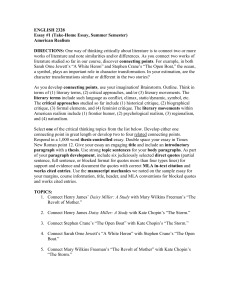

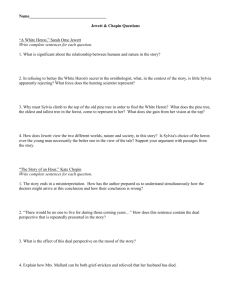
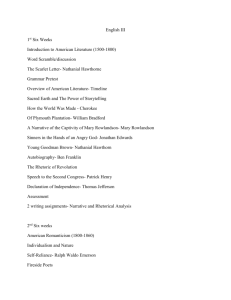


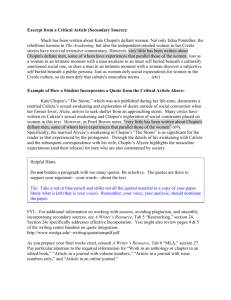
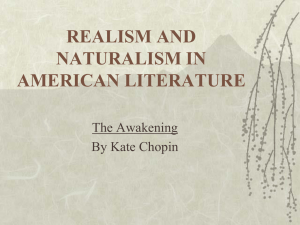

![The mysterious Benedict society[1]](http://s2.studylib.net/store/data/005310565_1-e9948b5ddd1c202ee3a03036ea446d49-300x300.png)

